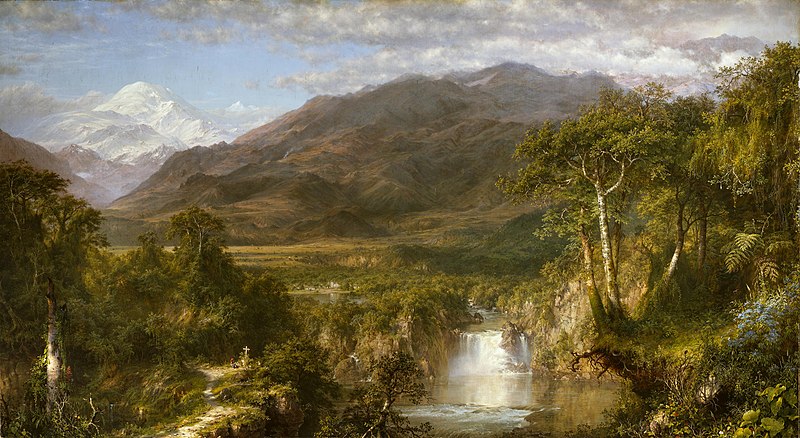Friedrich Georg Weitsch, Alexander von Humboldt, 1806
Images: Wikimedia Commons
Andrea Wulf has just won another prize for The Invention of Nature and I am not surprised as it is a really good read. In addition to telling the life of Alexander von Humboldt, she has chapters on other great men who he influenced: Goethe, Jefferson, Bolívar, Darwin, Thoreau, Haeckel, Muir and America's first environmentalist, George Perkins Marsh. Of course Humboldt was so protean and long-lived that she could have included far more people, at the risk of turning her own book into something the size of Humboldt's thirty-four volume Voyage to the Equinoctial Regions of the New Continent. The one time I have referred to Humboldt's influence on this blog was in connection with Carl Gustav Carus and his notion of Earth-life painting - Carus doesn't make it into the book at all. Here though are some of the artists, writers and composers she does mention, in connection with three of Humboldt's most widely read publications.
In 1808 Humboldt published Views of Nature in Germany and France, combining scientific facts with poetic landscape description. Reading it, Goethe told him 'that I plunged with you into the wildest regions' and Chateaubriand said that 'you believe you are surfing the waves with him, losing yourself with him in the depths of the woods.' Later it inspired Darwin, Thoreau and Emerson. Jules Verne used passages verbatim in his Voyages Extraordinaires, particularly The Mighty Orinoco. Captain Nemo owned the complete works of Alexander von Humboldt.
In 1814 Humboldt's account of his travels in South America, the Personal Narrative, appeared in England and started to influence writers like Wordsworth, who adapted a passage for his sonnet sequence on the River Duddon. Coleridge may already have read him in the original German; he had spent some time with Wilhelm, the 'brother of the great traveller', in Rome in 1805. Byron had fun with the idea of Humboldt's cyanometer, a device for measuring the blueness of the sky which he had taken on his travels. Here are the lines from Don Juan:
Humboldt, 'the first of travellers,' but not
The last, if late accounts be accurate,
Invented, by some name I have forgot,
As well as the sublime discovery's date,
An airy instrument, with which he sought
To ascertain the atmospheric state,
By measuring 'the intensity of blue:'
O, Lady Daphne! let me measure you!
Horace Bénédicte de Saussure, cyanometer, 1760Saussure (like Humboldt a scientist and mountaineer) originally devised the cyanometer
In 1845, after eleven years' work, Humboldt published Cosmos, a huge success with students, scientists, politicians and even royalty (Prince Albert ordered a copy). Hector Berlioz declared him 'a 'dazzling writer; the book was so popular among musicians, Berlioz said, that he knew one who had 'read, re-read, pondered and understood' Cosmos during his breaks at opera performances when his colleagues played on.' In America, Emerson got hold of one of the first copies, Poe was inspired by it to write his visionary last work Eureka, and Whitman wrote Leaves of Grass with a copy of Cosmos on his desk.
Frederic Edwin Church, The Heart of the Andes, 1859
On the day Humboldt died in May 1859, New Yorkers were queuing to see a painting he had inspired: The Heart of the Andes by Frederic Edwin Church. Church had gone to South America and retraced Humboldt's route, returning to paint landscapes that united poetic feeling with scientific accuracy. The New York Times described him as 'the artistic Humboldt of the new world.' Church wanted his painting to travel to Berlin so that the old man could see again 'the scenery which delighted his eyes sixty years ago.' When he heard the news of Humboldt's passing, Church said that it felt as if he had 'lost a friend.'
Alexander von Humboldt, Naturgemälde, 1807
The Invention of Nature begins on a high ridge of Chimborazo, the great extinct volcano that Humboldt climbed in 1802. Nobody had ever been this high before, not even the early balloonists. After descending to the Andean foothills, Humboldt began to sketch the first version of his famous Naturgemälde - an image of Chimborazo familiar to those of us professionally interested in infographics but more importantly, as Andrea Wulf emphasises, an encapsulation in one two-by three foot page of Humboldt's new vision of nature as a living whole. She ends her book with a beautiful quote from his friend Goethe, who compared Humboldt to a 'fountain with many spouts from which streams flow refreshingly and infinitely, so that we only have to place vessels under them.'




No comments:
Post a Comment